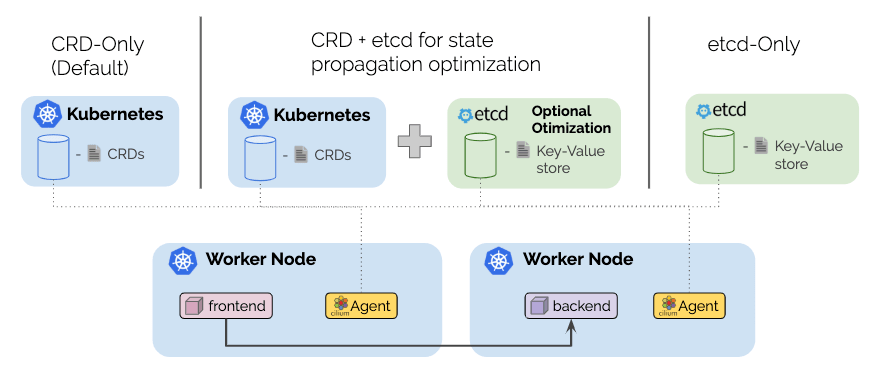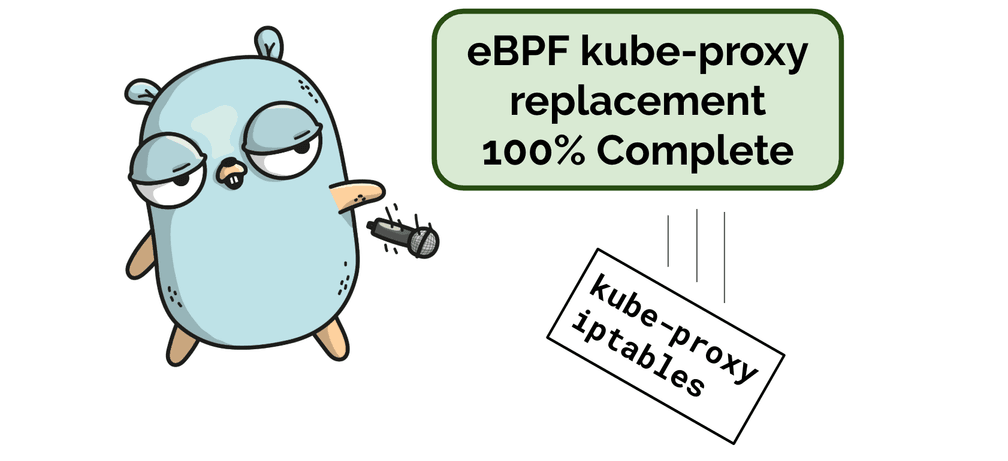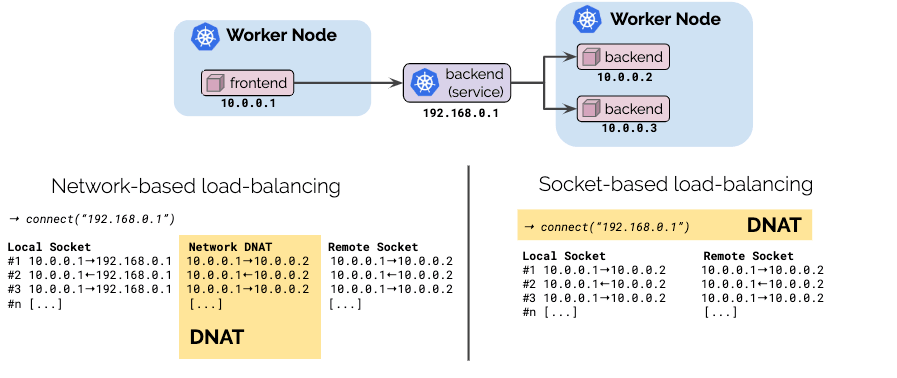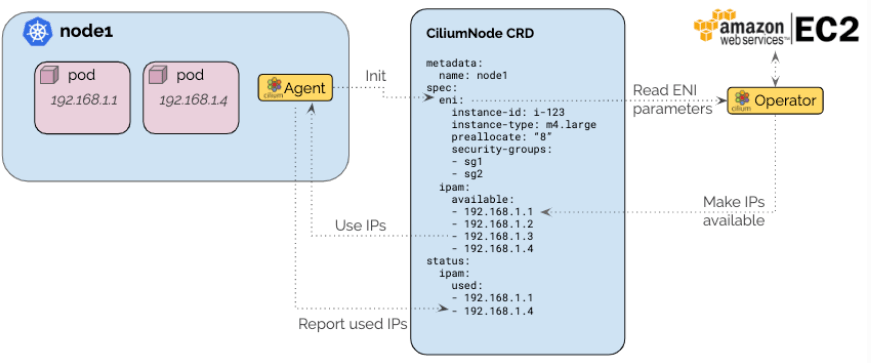Cilium 1.6: KVstore-free operation, 100% kube-proxy replacement, Socket-based load-balancing, Generic CNI Chaining, Native AWS ENI support, ...

We are excited to announce the Cilium 1.6 release. A total of 1408 commits have been contributed by the community with many developers contributing for the first time. Cilium 1.6 introduces several exciting new features:
- KVStore free operation: The addition of a new CRD-based backend for security identities now allows to operate Cilium entirely without a KVstore in the context of Kubernetes. (More details)
- 100% Kube-proxy replacement: Operating a Kubernetes cluster without requiring to run kube-proxy has been a desire of many users. This release includes the final two features required to run a Kubernetes cluster without kube-proxy with Cilium fully replacing kube-proxy. (More details)
- Socket-based load-balancing: Socket-based load-balancing combines the advantage of client-side and network-based load-balancing by providing fully transparent load-balancing using Kubernetes services with the translation from service IP to endpoint IP done once during connection establishment instead of translating each network packet for the lifetime of a connection. (More details)
- Policy scalability improvements: The entire policy system has been improved to decouple handling of policy and identity definitions and moving to an entirely incremental model. This ensures that environments with high pod scheduling churn, e.g. several 100K pods across multiple clusters, can cope well in combination with constant policy definition changes. (More details)
- Generic CNI chaining: The 1.6 release introduces a new CNI chaining framework allowing to run Cilium on top of the majority of other CNI plugins such as Weave, Calico, Flannel, AWS VPC CNI or the Lyft CNI plugin. This enables using advanced features such as eBPF-based security policy enforcement, visibility, multi-cluster, encryption, and load-balancing while continuing to run whatever CNI plugin is already in-use. (More details)
- Native AWS ENI mode: A new datapath and IPAM mode allows to combine the efficiency of native AWS ENI routing with Cilium policy enforcement, encryption and multi-cluster. A new operator-based design, works around many problems known to large scale AWS ENI users with per node agents. (More details)
- ... and much more: For the full list of changes, see the 1.6 Release Notes.
What is Cilium?
Cilium is open source software for transparently providing and securing the network and API connectivity between application services deployed using Linux container management platforms like Kubernetes, Docker, and Mesos.
At the foundation of Cilium is a new Linux kernel technology called eBPF, which enables the dynamic insertion of powerful security, visibility, and networking control logic within Linux itself. eBPF is utilized to provide functionality such as multi-cluster routing, load balancing to replace kube-proxy, transparent encryption as well as network and service security. Besides providing traditional network level security, the flexibility of eBPF enables security with the context of application protocols and DNS requests/responses. Cilium is tightly integrated with Envoy and provides an extension framework based on Go. Because eBPF runs inside the Linux kernel, all Cilium functionality can be applied without any changes to the application code or container configuration.
See the section Introduction to Cilium for a more detailed general introduction to Cilium.
KVStore Free Operation (CRD storage)
Contributed by Ray Bejjani and others
This has been one of the long awaited features and it has finally landed. We have completed all work to run Cilium without requiring a key-value store. Starting with 1.6, it is possible to run Cilium entirely CRD-backed in a Kubernetes environment. The new modes in a nutshell:

-
New default: The new default mode derives all required information from standard Kubernetes resources and stores all state using Custom Resource definitions (CRDs).
-
Managed etcd: Building on top of the default mode, the managed etcd mode uses an etcd-operator to maintain an etcd cluster within the Kubernetes cluster and uses it to offload state propagation. This leads to better scalability while continuing to maintain Kubernetes as the source of truth for all state. If the etcd cluster fails, state propagation falls back to being CRD-based until etcd recovers.
This new managed etcd mode is more reliable than the previous etcd-operator mode in versions 1.5. Due to maintaining the source of truth in Kubernetes, failure of etcd is no longer critical.
-
External kvstore: This remains the most reliable mode for large-scale environments. It requires an external kvstore to be maintained. The Kubernetes etcd can be used or a dedicated etcd or consul cluster.
For more information, see the new Quick Installation section in the documentation.
Kube-proxy Removal
Contributed by Daniel Borkmann and Martynas Pumputis

The 1.6 release brings the last missing piece in the kube-proxy removal - support for services of the NodePort type and the ability to make Kubernetes services available for processes on the host and pods running in host networking. The new feature allows to finally run a fully functioning Kubernetes cluster without kube-proxy. This means that long lists of iptables rules are no longer needed to enable the Kubernetes Service abstraction.
Why does it matter?
The plot below shows a latency per HTTP GET request (lower is better) via a
Kubernetes service to a nginx Pod running on a remote host measured with ab
sending 100'000 sequential requests. As we can see, the eBPF service
implementation does not depend on number of services being deployed in a
cluster, while the kube-proxy implementation using iptables does.

The eBPF-based service implementation not only improves latency and throughput of a Kubernetes service traffic, it also reduces time and overhead when processing changes in a service definition. With iptables, entire tables of rules have to be replaced in the datapath whereas eBPF supports applying individual service changes in the datapath.
Another key difference is the deterministic behavior. An iptables-based service implementation requires multiple iptables rules for each service and service backend. This essentially creates a long list of rules which have to be traversed one by one. Depending on how far down the list the service to be matched is, the cost is higher, some service load-balancing will have the cost of only having to traverse a few rules, other packets will have to traverse thousands of rules before a match is found. The behavior is non-deterministic. With eBPF, the implementation uses hash tables so the lookup cost is close to O(1) and the behavior is deterministic as the benchmark above indicates as well.
Removal of the per-node iptables rules mess
Anyone who has been operating Kubernetes at non-trivial scale with more than a couple of dozen services, will have noticed, the vast amount of iptables rules generated. The following is an example of one Kubernetes service of type NodePort with two endpoints as backends:
Rules with kube-proxy (iptables)
-A KUBE-NODEPORTS -p tcp -m comment --comment "default/nginx:" -m tcp --dport 30905 -j KUBE-MARK-MASQ
-A KUBE-NODEPORTS -p tcp -m comment --comment "default/nginx:" -m tcp --dport 30905 -j KUBE-SVC-253L2MOZ6TC5FE7P
-A KUBE-SEP-PCCJCD7AQBIZDZ2N -s 10.217.1.154/32 -j KUBE-MARK-MASQ
-A KUBE-SEP-PCCJCD7AQBIZDZ2N -p tcp -m tcp -j DNAT --to-destination 10.217.1.154:80
-A KUBE-SEP-UFVSO22B5A7KHVMO -s 10.217.1.159/32 -j KUBE-MARK-MASQ
-A KUBE-SEP-UFVSO22B5A7KHVMO -p tcp -m tcp -j DNAT --to-destination 10.217.1.159:80
-A KUBE-SERVICES ! -s 10.217.0.0/16 -d 10.107.41.178/32 -p tcp -m comment --comment "default/nginx: cluster IP" -m tcp --dport 80 -j KUBE-MARK-MASQ
-A KUBE-SERVICES -d 10.107.41.178/32 -p tcp -m comment --comment "default/nginx: cluster IP" -m tcp --dport 80 -j KUBE-SVC-253L2MOZ6TC5FE7P
-A KUBE-SERVICES -m comment --comment "kubernetes service nodeports; NOTE: this must be the last rule in this chain" -m addrtype --dst-type LOCAL -j
KUBE-NODEPORTS
-A KUBE-SVC-253L2MOZ6TC5FE7P -m statistic --mode random --probability 0.50000000000 -j KUBE-SEP-PCCJCD7AQBIZDZ2N
-A KUBE-SVC-253L2MOZ6TC5FE7P -j KUBE-SEP-UFVSO22B5A7KHVMORules with eBPF-based k8s services
# This snippet is intentionally left blankNative eBPF NodePort and SNAT implementation
Under the hood, we attach a NodePort eBPF program to a network device which has
a default route on the host. This makes a NodePort service to be accessible via
IP address of the device. In addition, thanks to the new host-level services
feature, the NodePort service can be reached within the cluster from a host or
a Pod via loopback or cilium_host IP address.
When the service endpoint runs on the other host than a request was sent to, the eBPF program does the SNAT translation before forwarding the request to a host running the endpoint.
The feature can be enabled by setting enable-node-port to true. See the
NodePort Getting Started Guide
for more configuration options.
Socket-based load-balancing
Contributed by Daniel Borkmann and Martynas Pumputis

Load-balancing is typically done in one of the following ways:
-
The application performs client-side load-balancing and picks a destination endpoint itself. The benefit of this is that the cost of load-balancing is paid once upfront when a connection is established and no additional overhead exists for the lifetime of the connection. The downside of this approach is that this is not transparent to the application.
-
The network performs the load-balancing via a middle box by translating requests to a particular service IP. The advantage of this method over client-side load-balancing is the transparency. The application itself is not involved. However, the downside is that each network packet needs to have its IP addresses changed in both the request and response direction.
With Cilium 1.6, we are introducing socket-based load-balancing which combines the advantages of both approaches:
-
Transparent: Load-balancing remains 100% transparent to the application. Services are defined using standard Kubernetes service definitions.
-
Highly efficient: By performing the load-balancing at the socket level by translating the address inside the
connect(2)system call, the cost of load-balancing is paid upfront when setting up the connection and no additional translation is needed for the duration of the connection afterwards. The performance is identical as if the the application talks directly to the backend.
Diving Deeper
This socket-based load-balancing implementation makes use of recent eBPF cgroup
hooks in the Linux kernel which Cilium attaches to connect(2), sendmsg(2)
and recvmsg(2) system calls. The eBPF programs then rewrite sockaddr_in{,6}
data with information for the service backend. For UDP services we've extended
the kernel to enable recvmsg(2) (more
details)
for reverse sock address translation. The advantage of these hooks are that
they i) operate transparent to the application, ii) they operate in a device
independent manner, and iii) the backend selection only needs to be performed
e.g. at connect(2) time. Latter means that packets headers don't need to be
NAT'ed throughout the lifetime of the connection. Thus, to the kernel it looks
as if the application connects to the backend directly. Host-reachable services
are available for both TCP and UDP where in case of UDP both connected and
unconnected UDP is supported.
This feature can be enabled by setting enable-host-reachable-services to
"true" for the daemon config which then exposes both TCP and UDP services.
Protocol exposure can be controlled via daemon flag
host-reachable-services-protos that has a default value of "tcp,udp" and
can be set to one of the two for older kernel compatibility.
Generic CNI Chaining
Contributed by Thomas Graf and Laurent Bernaille
CNI (Container Networking interface) is the Kubernetes API for plugins to provide networking to Kubernetes pods. While Cilium directly implements this API as well, there are scenarios where it is desirable to use another CNI plugin for networking and use Cilium to provide additional functionality on top such as security policy enforcement, multi-cluster, encryption, or load-balancing.

For all of these users, we are introducing generic CNI chaining. It is a new pluggable architecture built on top of the standard chaining feature of CNI. All veth based CNI plugins can be integrated with a new generic veth chainer that should work out of the box in combination with any CNI plugin that uses veth devices to connect pods. Other CNI plugins can be integrated by writing a bit of Go code to define the interface between Cilium and that CNI plugin.
Policy Scalability
Contributed by Ian Vernon, Jarno Rajahalme, and Joe Stringer
While Cilium release 1.5 focused on scalability for Cilium running in clusters with a large number of nodes, release 1.6 improves scalability of node-local operations in these environments, specifically policy computation. Policy computation in Cilium occurs for each pod running on a node whenever global cluster state or policy has been changed by a cluster administrator, for example when a new pod has launched, or when local policy-relevant state changes, such as when Cilium learns a new IP address corresponding to an FQDN which is allowed by policy. When these events happen, Cilium determines which rules select each of the local endpoints, and figures which counterparts are allowed (e.g., other pods within the cluster, FQDNs, CIDRs, etc.). As part of this computation, Cilium now caches which label identities match each label selector in the applicable policy rules. For instance, take the following policy rule:
apiVersion: 'cilium.io/v2'
kind: CiliumNetworkPolicy
description: 'L3 ingress from env=qa'
metadata:
name: 'l3-ingress-qa'
spec:
endpointSelector:
matchLabels:
app: foo
ingress:
- fromEndpoints:
- matchLabels:
env: qaThe rule applies on any pod running with label app=foo. Within the rule, we
can see that we should allow ingress from any remote destination corresponding
to env=qa. Given a cluster that has multiple endpoints with label env=qa,
e.g., {app=foo, env=qa}, {app=bar, env=qa}, {app=baz, env=qa}, a unique
numeric identifier, called a security identity, is allocated to each of these
sets of labels, e.g.:
51718 --> {app=foo, env=qa}
56949 --> {app=bar, env=qa}
61625 --> {app=baz, env=qa}As soon as the allocation of these security identities is distributed to a local node, Cilium matches each locally used selector in the policy against the new identity and caches this information so that this matching operation need not be performed from scratch again later. You can see this caching in action:
$ cilium policy selectors -o json
[
{
"identities": [
51718,
56949,
61625
],
"selector": "\u0026LabelSelector{MatchLabels:map[string]string{any.env: qa,k8s.io.kubernetes.pod.namespace: default,},MatchExpressions:[],}",
"users": 2
}
]The caching of this information now has a single upfront cost, and after that, a simple map lookup for the selector suffices to see to which remote destinations it corresponds. This allows for efficient policy computation for a large number of identities for a large number of rules. As part of this new selector caching functionality, Cilium can now update the eBPF policy state without performing a full policy recomputation when new pods are spun up in anywhere in the cluster. We are proud to say that now Cilium can efficiently compute the policy for a pod when thousands of rules are configured in large-scale clusters that run thousands of pods. The benchmark results speak for themselves:
PASS: resolve_test.go:225: PolicyTestSuite.BenchmarkRegenerateL3IngressPolicyRules 1000 2150217 ns/op
PASS: resolve_test.go:235: PolicyTestSuite.BenchmarkRegenerateL3EgressPolicyRules 1000 2209893 ns/opThese benchmarks test different types of rules against a large number of identities. The profiling output above indicates that even with 1000 rules of either ingress or egress, and 3000 identities, layer-3 policy computation takes around 2 milliseconds when the selector caching has been performed upfront.
Along with these policy calculation changes, we improved also other aspects of generating the endpoint datapath. In cases with large amounts of identity churn---that is, upwards of dozens of pods being created in the cluster each second---it commonly takes less than 50 milliseconds to update the datapath of each endpoint to realize the whitelist policy and how it applies to traffic destined for the new endpoints in the cluster.
Native AWS ENI Datapath
Contributed by Thomas Graf, Vlad Ungureanu, and Ryan McNamara

The AWS ENI allocator is specific to Cilium deployments running in the AWS cloud and performs IP allocation based on IPs of AWS Elastic Network Interfaces (ENI) by communicating with the AWS EC2 API.
The architecture ensures that only a single operator communicates with the EC2 service API to avoid rate-limiting issues in large clusters. A pre-allocation watermark allows to maintain a number of IP addresses to be available for use on nodes at all time without requiring to contact the EC2 API when a new pod is scheduled in the cluster.
The new IPAM mode is coupled with a specific AWS ENI datapath connects pods using AWS ENI IPs in a direct routing mode that is compatible with the multi-cluster, policy enforcement and load-balancing subsystem.
High-scale Dataplane for Transparent Encryption
Contributed by John Fastabend, Laurent Bernaille, and Robert Boll
Cilium provides transparent encryption support utilizing eBPF to orchestrate encryption using the Linux kernel crypto subsystem. The Cilium 1.6 release expands this support with a new subnet mode allowing users to specify subnets of IPs that should have transparent encryption applied. Cilium will also manage the FIB table, automatically adjust MTUs, and expose flow level encryption status to ensure connectivity.
Node to node encryption
The encryption support is extended to also cover node to node communication even if no pod communication is involved. This allows to easily encrypt all network traffic regardless whether the source or destination endpoint is a Kubernetes pod.
Helm Charts
With the growing number of supported datapath and control plane configurations, maintaining pre-generated YAML resources for deployments has become hard. As part of this, we have integrated with Helm and now provide several Helm charts which can be used for templating and deployment. All guides have been converted to use Helm.
Example: Configuring Cilium for GKE
helm template cilium \
--namespace cilium \
--set nodeinit.enabled=true \
--set nodeinit.reconfigureKubelet=true \
--set nodeinit.removeCbrBridge=true \
--set global.cni.binPath=/home/kubernetes/bin \
> cilium.yaml
kubectl create namespace cilium
kubectl create -f cilium.yaml1.6 Release Highlights
- Policy
- New selector cache to massively speed up correlation of label based selectors with identity objects
- The policy map size is now configurable if more than the default 16K are needed
- Labels created from annotations are now ignored from the identity by default
- Allow all policy is now enforced with a single entry in the datapath table for reduced overhead
- New garbage collector to remove obsolete nodes in the status section of CiliumNetworkPolcies
- Kvstore free operation
- CRD-backing for all required state storage
- Ability to start Cilium without a key-value store configured
- Kubernetes
- Simplified init container to remove cilium state
- Distinct user-agent to identify Cilium communication with the apiserver
- Patch Kubernetes Node status with NetworkUnavailable=false
- New option to skip creation of CRDs on startup
- The container runtime integration is now disabled by default. It only needs to be enabled if users want container runtime labels in addition to pod labels to identify services.
- Kubernetes 1.15 support
- Removed dependency of operator to reach the cluster DNS
- Generic CNI chaining
- New CNI chaining plugin architecture
- Built-in chaining support for aws-cni-vpc, Calico, Portmap, and Weave-Net
- Generic veth chaining plugin to run on top of any veth based CNI plugin
- Resource consumption
- Numerous code optimizations to reduce memory allocations and footprint in environments with a large number of pods.
- New minimal status response to reduce resource consumption
- New option to disable status of CiliumNetworkPolicy to reduce resource size
- Socket-level load-balancing
- Highly efficient load-balancing of Kubernetes services at socket level
- Load-balancing of Kubernetes services for host processes
- Datapath
- New TPROXY based L7 redirection datapath to no longer require to rewrite any packet headers to transparently redirect to proxies.
- Use a static IP 169.254.42.1 for service redirection loopback SNAT instead of allocating an IP
- The new datapath event aggregation now defaults to maximum
- New datapath mode (--enable-endpoint-routes) where packets to local endpoints are routed via a per endpoint route instead via a separate veth pair
- New native AWS ENI datapath mode
- IPAM
- New CRD-backed IPAM mechanism
- AWS ENI allocation method
- NodePort Support
- Native eBPF implementation of NodePort services (--enable-node-port)
- Transparent Encryption:
- Node to node encryption in addition to pod to pod and pod to node
- New metric to count encrypted and unencrypted traffic
- CLI
- New
cilium identity list --endpointscommands - New
cilium policy selectorsto list content of the policy selector cache
- New
- Documentation
- All guides have been rewritten to use Helm charts
- New guide on how to use Cilium with Kata containers
- New guide for simple deployment on microk8s
- Additional troubleshooting documentation
- Istio
- Support for 1.2.4
Getting Started
New to Cilium? Follow one of the Getting Started Guides.
Upgrade Instructions
As usual, follow the upgrade guide to upgrade your Cilium deployment. Feel free to ping us on Slack.
Release
- Release Notes & Binaries: 1.6.0
- Container image:
docker.io/cilium/cilium:v1.6.0


